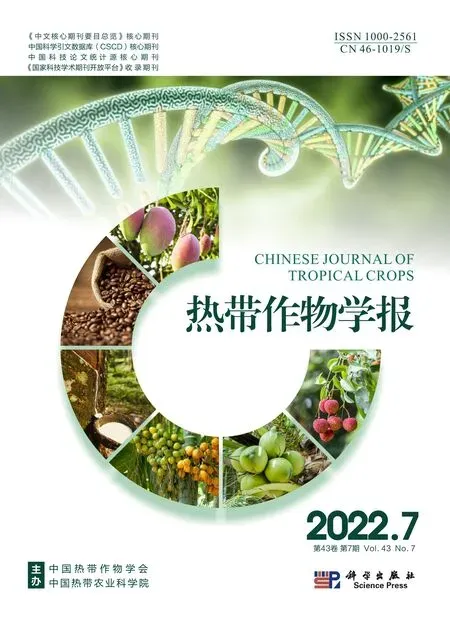Effects of Different Forms and Ratios of Nitrogen on Yield and Quality of Leaf-vegetable Sweet Potato Stem Tips
2022-08-06LIChengyangCHAIShashaLIUYiSoviguidiDekaReineJudesseWANGLianjunLEIJianCHENGXianliangYANGYuanyuanYANGXinsunZHANGWenying2
LI Chengyang, CHAI Shasha, LIU Yi, Soviguidi Deka Reine Judesse, WANG Lianjun, LEI Jian, CHENG Xianliang, YANG Yuanyuan, YANG Xinsun, ZHANG Wenying2
Effects of Different Forms and Ratios of Nitrogen on Yield and Quality of Leaf-vegetable Sweet Potato Stem Tips
LI Chengyang1,2, CHAI Shasha1*, LIU Yi1,2, Soviguidi Deka Reine Judesse1,2, WANG Lianjun1, LEI Jian1, CHENG Xianliang1, YANG Yuanyuan1, YANG Xinsun1**, ZHANG Wenying2**
1. Food Crops Institute, Hubei Academy of Agricultural Sciences / Hubei Engineering and Technology Research Center of Sweet Potato / Hubei Key Laboratory of Food Crop Germplasm and Genetic Improvement, Wuhan, Hubei 430064, China;2. Research Center of Crop Stresses Resistance Technologies / Yangtze University, Jingzhou, Hubei 434025, China
This study was conducted to solve the problems of low yield, poor quality, and ecological environment deterioration caused by unreasonable fertilization in the planting process of leaf-vegetable sweet potato. As the main part of agricultural fertilizer input, nitrogen fertilizer is an important factor affecting the yield and quality of leaf-vegetable sweet potato. The response mechanism of yield and quality of leaf-vegetable sweet potato to nitrogen form ratio was revealed by setting different nitrogen form ratio treatments and according to the changes of related indexes of yield and quality of leaf-vegetable sweet potato stem tip. It provides a theoretical basis for reasonable fertilization to improve the yield and quality of leaf-vegetable sweet potato and reduce environmental pollution caused by unreasonable fertilization. This study was a field experiment. Two main leaf-vegetable sweet potato varieties, ‘Fushu 18’ and ‘Eshu 10’, were used. A field experiment with the two-factor split-plot experiment design with five treatmentswas conducted: (1) NH4+-N∶NO3–-N∶CONH2-N= 1∶1∶1 (N1); (2) NH4+-N∶NO3–-N∶CONH2-N= 1∶0∶2 (N2); (3) NH4+-N∶NO3–-N∶CONH2-N= 2∶0∶1 (N3); (4) NH4+-N∶NO3–-N∶CONH2-N= 1∶2∶0 (N4); (5) NH4+-N∶NO3–-N∶CONH2-N= 2∶1∶0 (N5). The results showed that N4 and N5 treatments significantly increased shoot tip yield, total phenol content, total flavonoids content, soluble sugar content, PAL activity andgene expression of leaf-vegetable sweet potato. There were significant differences between different treatments in the same period. With the continuous progress of the growth period, the changes of various indicators showed a trend of increasing first and then decreasing. Among them, the effect of N4treatment was more significant. Except the soluble sugar content was the lowest under N3treatment, the other indicators were the lowest under N2treatment. The correlation analysis confirmed that total phenols, total flavonoids, soluble content and PAL enzyme activity were positively correlated withgene expression, while the soluble sugar content was negatively correlated with gene expression, indicating that the change of soluble sugar content was not correlated withgene expression. It can be seen from the treatment of nitrogen morphology ratio that N4and N5treatments provided more NO3--N for plants than N2and N3treatments, suggesting that NO3--N played a more important role in promoting the growth and development of leaf-vegetable sweet potato, but the effect of CONH2-N on yield and quality of sweet potato was not prominent in this experiment. N4treatment (NH4+-N∶NO3--N∶CONH2-N= 1∶2∶0) was the best combination to promote the yield and quality of leaf-vegetable sweet potato. The results of this study could provide a theoretical basis for reasonable fertilization to obtain ideal crop yield and quality, and provide reference for related research on other crops.
(L.) Lam.; nitrogen form ratio; total polyphenols; total flavonoids; soluble sugar; phenylalanine ammonia-lyase
1 Introduction
Sweet potato [(L.) Lam.] is considered a valuable source of natural products that can be used in the food industry and the manufacture of drugs involved in the treatment of various diseases[1]. With increasing research on sweet potato, new varieties of leaf-vegetable sweet potato have emerged. The young stem, rich in nutrients, attracts many consumers. The tips of the stems are one of the most harvestable components of leaf-vegetable sweet potato, and the factors and processes regulating the yield and quality of stem tips have become important topics in leaf-vegetable sweet potato research[2-4]. As plant growth and development are affected by external environmental factors[5], it would be of great interest to understand the effects of these factors on the yield and quality of leafy sweet potato to promote the development of the leaf-vegetable sweet potato industry.
Polyphenols and flavonoids present in the stem tips of leaf-vegetable sweet potato are thought to scavenge free oxygen radicals through the antioxidant properties[6]. Previous studies have revealed that phenylalanine ammonia-lyase (PAL) plays a key regulatory role in the synthesis of polyphenols and flavonoids[7-9]. Environmental factors such as light, moisture, and temperature affect crop yields. In addition, nitrogen (N), which is the principal mineral element in plant nutrition can also affect plant growth and crop yield[10]. However, excessive application of nitrogen fertilizers causes loss of crop productivity and environmental pollution, threatening sustainable agriculture[11].
The choice of nitrogen forms in the fertilizer formulation is one of the most important factors for good production. Nitrate (NO3–-N), ammonium (NH4+-N), and amide (CONH2-N) are three important forms of nitrogen for plant uptake[12]. Exploring the proper form and ratios of nitrogen to improve the yield and quality of leaf-vegetable sweet potato has become an issue for cultivation. However, there is little research on the subject. This study seeks to determine the effects of different forms of nitrogen on the yield and quality of leaf-vegetable sweet potato.
2 Materials and methods
2.1 Plant materials and experimental designs
Two leaf-vegetable sweet potato varieties, ‘Fushu 18’ (F18) and ‘Eshu 10’ (E10), were used in this study. A field experiment was conducted at Hubei Academy of Agricultural Sciences, Wuhan, China (30°29′N, 114°18′E; altitude 20 m) from 2020 to 2021. The temperature was between 19 and 28℃, the light period was 11-14 h, and the average relative humidity was around 84%. Two-week-old seedlings of ‘Fushu 18’ and ‘Eshu 10’ were transplanted into the soil at 14% moisture. The substrate properties were analyzed before transplanting with pH (4.7), total N (23.9 mg/L), P (19.4 mg/L), and K (89.32 mg/L). A two-factor split-plot experiment design was used with three replications. In the subplots, five nitrogen ratio levels were set according to the three forms of nitrogen (Tab. 1).

Tab. 1 Treatment matrix showing ratio of nitrogen forms
2.2 Sampling and measurements
To observe the growth and development of the sweet potato varieties, the plants were sampled at 35, 50, 65, 80 and 95 days after planting (DAT). Fresh stem tips were used to determine the yield. The tips were oven-dried at 120℃ for 20 min, and then at 70℃ for 48 h prior to determination of polyphenols, flavonoids, and total soluble sugars. The dried powder samples of stem tips were extracted with ethanol (75%) until complete extraction. Then it was filtered to give liquid masses. Total polyphenols content was determined by the Folin-Ciocalteu reagent method with modification[13]. The total flavonoids content of crude extracts was estimated by the aluminum nitrate colorimetric method as described[14]. Total soluble sugars in the stem tips tissues were assayed following the method of KARKACIER[15].
Undeveloped young leaves from the stem tips were selected for PAL enzymatic activity and fluorescence expression of. The activity of the PAL enzyme in stem tip samples was determineand the leaves were ground in phosphate buffer. The mixed homogenate was centrifuged at 12 000×for 20 min, 30℃ distilled water for 30 min, and the observations were recorded at 290 nm. Total RNA of sweet potato leaves was extracted using TransZol Up reagent (TransGen, https://www.transgen.com. cn/). Subsequently, the first-strand cDNA was synthesized in a 20 μL reaction mixture by using TransScript (TransGen, ttps://www.transgen.com.cn/) and stored at –20℃. Gene-specific primer sequences for theandgene as listed in (Tab. 2). The PCR program was as follows: 94℃ for 5 min, followed by 35 cycles of 94℃ for 30 s, 55℃ for 1 min, and 72℃ for 1 min, then 72℃ for 10 min.

Tab. 2 Specific PCR primers forβ-Actin and IbPAL
2.3 Data processing
Data were analysed by the SAS V9.2 (Statistical Analysis System Version 9.2, 2012, SAS Institute Inc., Cary, NC, USA). One-way ANOVA with Duncan’s HSD (honestly significant difference) test was used to detect the difference at the level<0.05. Principal component analysis and weight analysis were processed using the SPSS Statistics 22.0.0.0 software.
3 Results and analysis
3.1 Yield of plant stem tips
Stem tip growth was measured for E10 and F18 varieties over one year. The variation of stem tip yields with the different nitrogen forms and ratios conditions is presented (Fig. 1). It was noted that the yield of the stem tip of the two leaf-vegetable sweet potato varieties showed a tendency to initially increase and then decrease over time. The highest yield was observed at 65 DAT, while at 95 DAT the yield was the lowest. During the same period, the stem tip yield of the two varieties in treatment N4was significantly higher than that of other treatments, and the yield level of the N5treatment was also maintained at a higher level, while the yield of the stem tip in the N2treatment was the lowest.
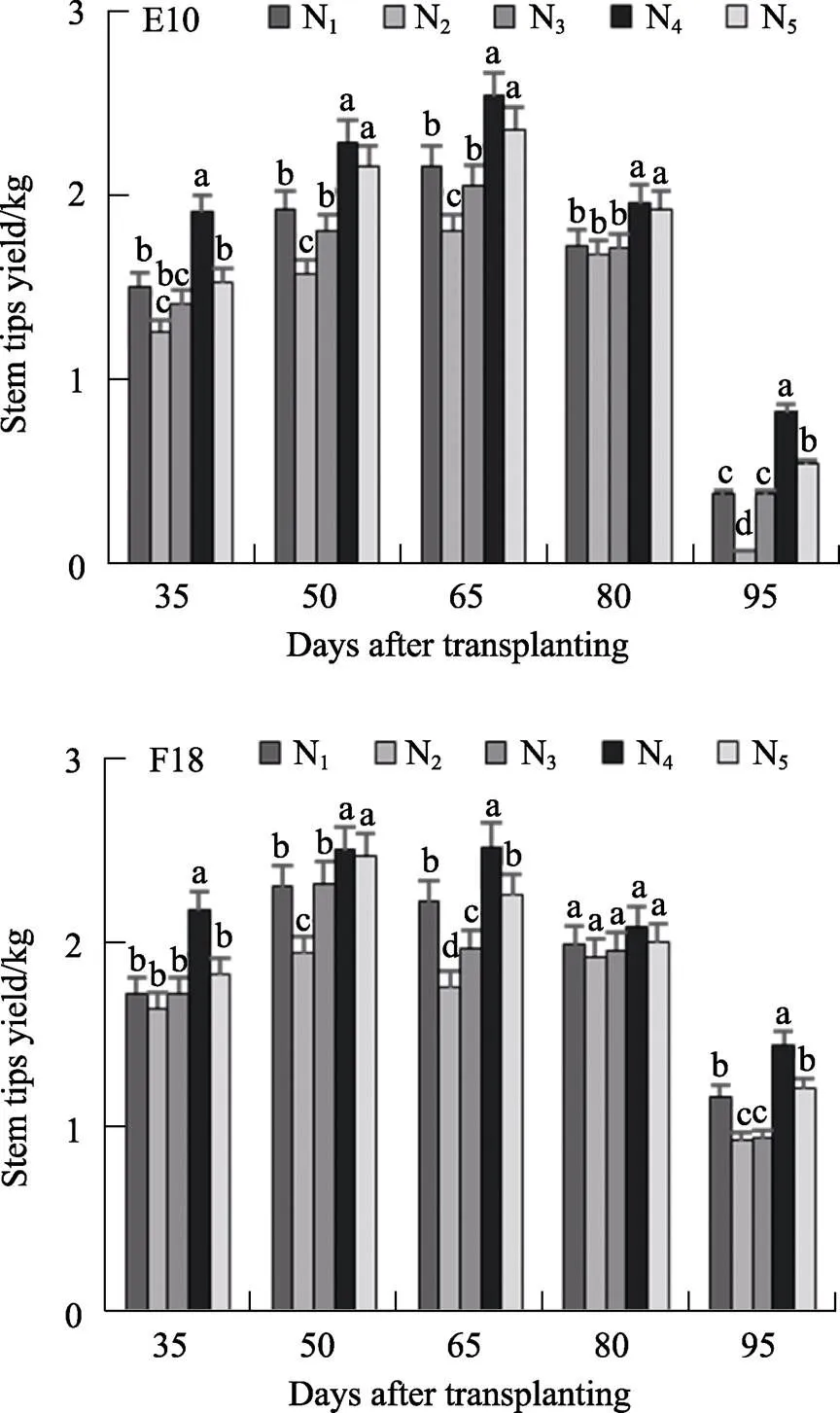
Different lowercase letters indicate significant difference between different treatments in the same period (P<0.05).
3.2 Quality of plant stem tips
The total polyphenols, flavonoids, and soluble sugars of leaf-vegetable sweet potato stem tips varied with the different forms and ratios of N (Tab. 3). The total polyphenol content is expressed as gallic acid equivalent (GAE). The amount in the stem tips of both varieties was between 37.71-141.66 mg/g, and varied significantly across the treatment period (<0.05). With the advancement of the fertility process, the total phenol content increased initially and then decreased with a peak observed at 65 DAT. Variety E10 exhibited low total phenol content at 35 and 95 DAT, while the lowest amount in F18 was observed at 95 DAT. The leaf-vegetable sweet potato stem tips in treatment N4accumulated more total phenol, whereas in the N2treatment the amount was lowest.
The total flavonoid content is expressed in rutin equivalent (RE). It varied significantly (<0.05) in the two varieties with a value ranging from 8.34 to 40.06 mg/g. As the growth period increased, the variation in the total content of flavonoids in two varieties showed a tendency to initially decrease then increase, and then to decrease once again. Increased accumulation is observed after 50 DAT, but this amount decreased after 65 DAT. Likewise, the total flavonoid content was highest under treatment N4and lowest under treatment N2.
However, the variation in the soluble sugars content was not significantly different between the two varieties. Total sugar tended to increase and then decrease, reaching its maximum on 65 DAT, while the lowest values were observed at 35 or 95 DAT. During the same period, the soluble sugar content was highest under treatment N4but lowest in the N3treatment.

Tab. 3 Tuber quality indicators of leaf-vegetable sweet potato plants under different nitrogen forms and ratios
Note: Different lowercase letters in the same column indicate significant difference between different treatments in the same period (<0.05).
3.3 PAL enzyme activity and IbPAL expression
The enzymatic activity of the PAL in E10 and F18 showed a final downward trend after increasing throughout the reproductive period (Fig. 2). The ratio of different nitrogen patterns was significantly positively correlated with enzyme activity (<0.05). PAL enzyme activity peaked on 80 DAT and then decreased, with the lowest enzyme activity on 95 DAT. Enzyme activity in treatment N4was maintained at the highest level in all periods, whereas enzyme activity under treatment N2is significantly lower than in other treatments. Under the conditions of this experiment, treatment N4can significantly improve PAL enzyme activity.
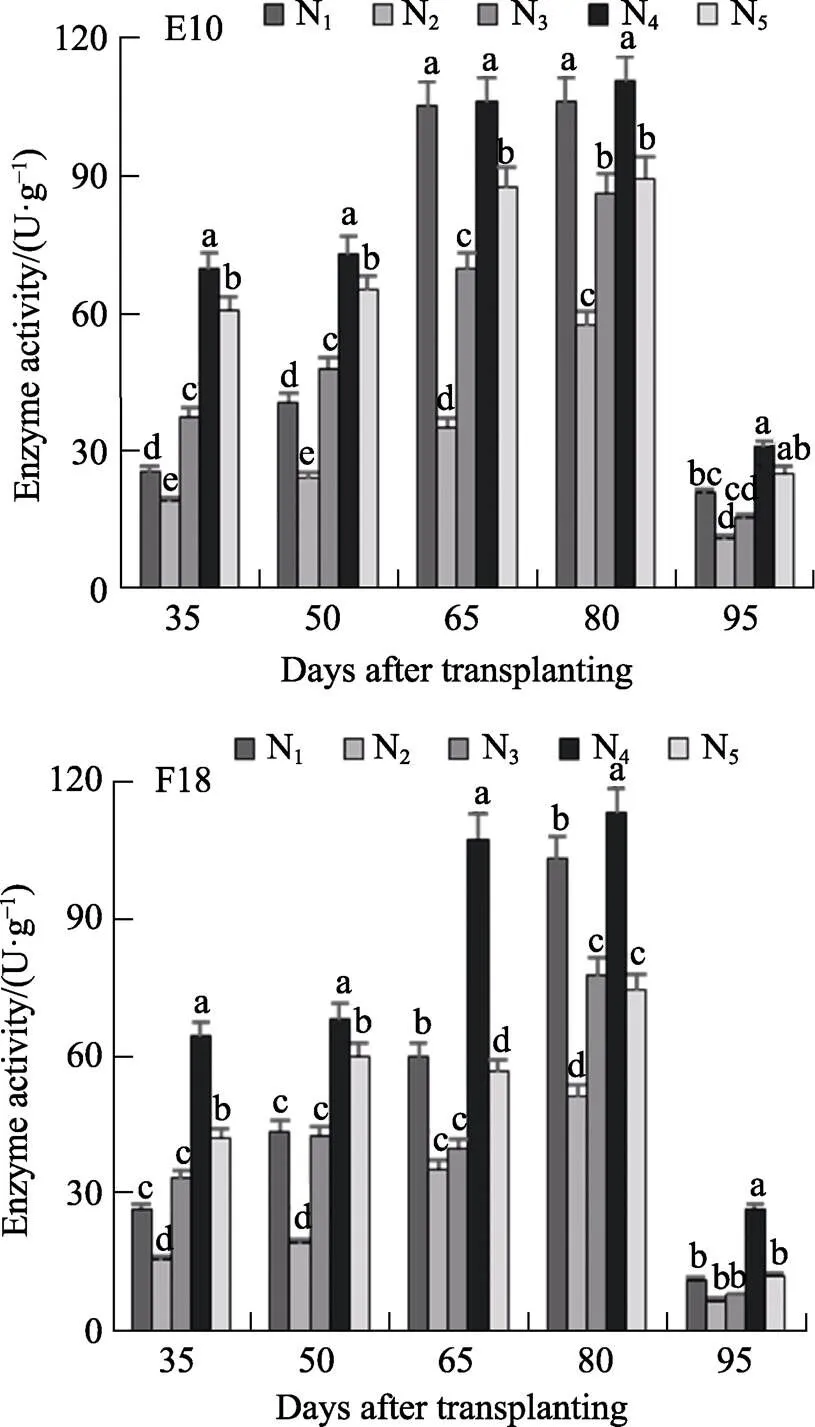
Different lowercase letters indicate significant difference between different treatments in the same period (P<0.05).
It was observed that PAL gene expression varied with different forms and ratios of N (Fig. 3). In both varieties the gene was up-regulated and peaked at 80 DAT but was down-regulated at 30 or 95 DAT. The expression ofin the N4treatment was significantly higher than in other treatments, with the N2treatment exhibiting the lowest expression level. In comparison with Fig. 2, PAL enzyme activity showed the same trend as that of expression of, and they both reach their respective peaks on 80 DAT with the maximum value observed for treatment N4.
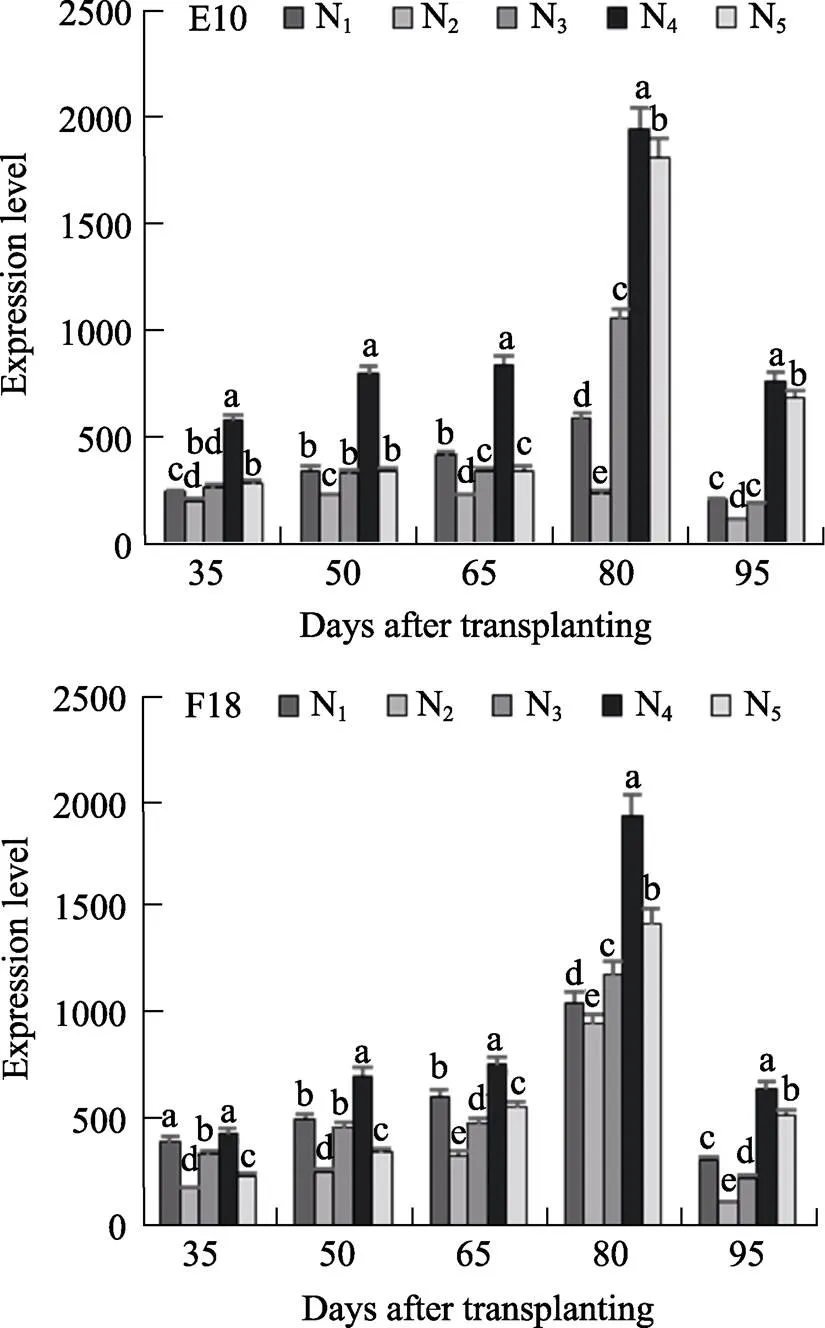
Different lowercase letters in each column indicate significant difference between different treatments in the same period (P<0.05).
3.4 Correlation analysis
There is a significant correlation betweengene expression and quality components except for soluble sugar (Tab. 4). Soluble sugar was significantly positively correlated with total polyphenols and total flavonoids, significantly positively correlated with PAL enzyme activity, and negatively correlated withexpression. The activity of total polyphenols, total flavonoids, and PAL enzymes was significantly positively correlated withexpression.
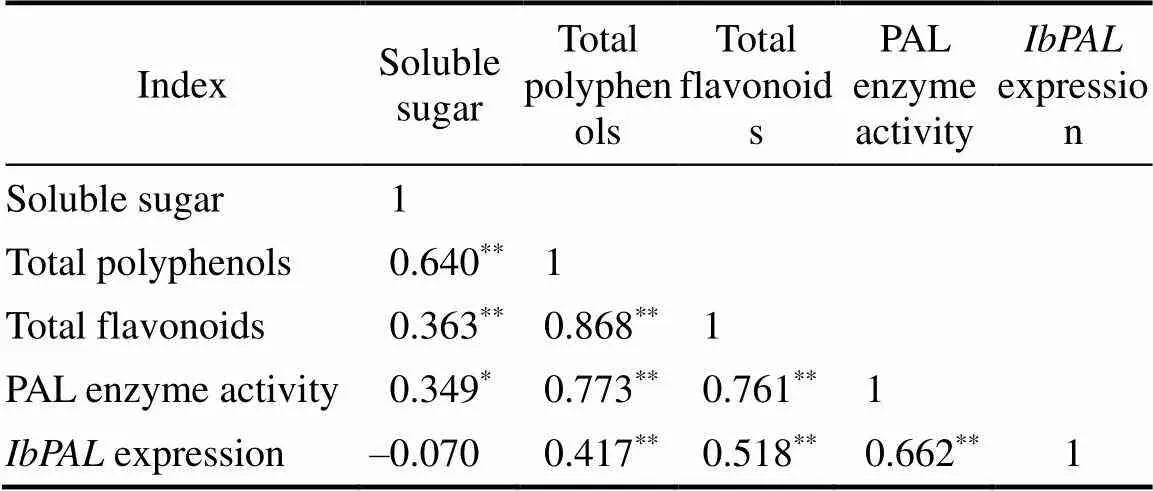
Tab. 4 Correlation analysis of IbPAL gene expression and quality components
Note:*indicates significant correlation at<0.05, and**indicates extremely significant correlation at<0.01.
3.5 Principal component analysis and weight analysis
The principal component is the linear combination of the original indicators, and the weight of each indicator is the feature vector, which indicating the importance of each indicator for the principal component and determines the practical significance of the main component. The principal component analysis showed that the contribution rate of the first two principal components of leaf-vegetable sweet potato under nitrogen form ratio was 64.703% and 23.006%, respectively, and the cumulative contribution rate was 87.709% (>85%) (Tab. 5). Therefore, the first two principal components represent the comprehensive information of all traits of 87.709%, which can better explain the information contained in the original variables. The characteristic value of the first principal component was 3.235, and the variance contribution rate was 64.703%, that is, the first principal component is determined by total preservation, total flavonoids, PAL enzyme activity, andexpression, while the second principal component is determined by Soluble sugar.
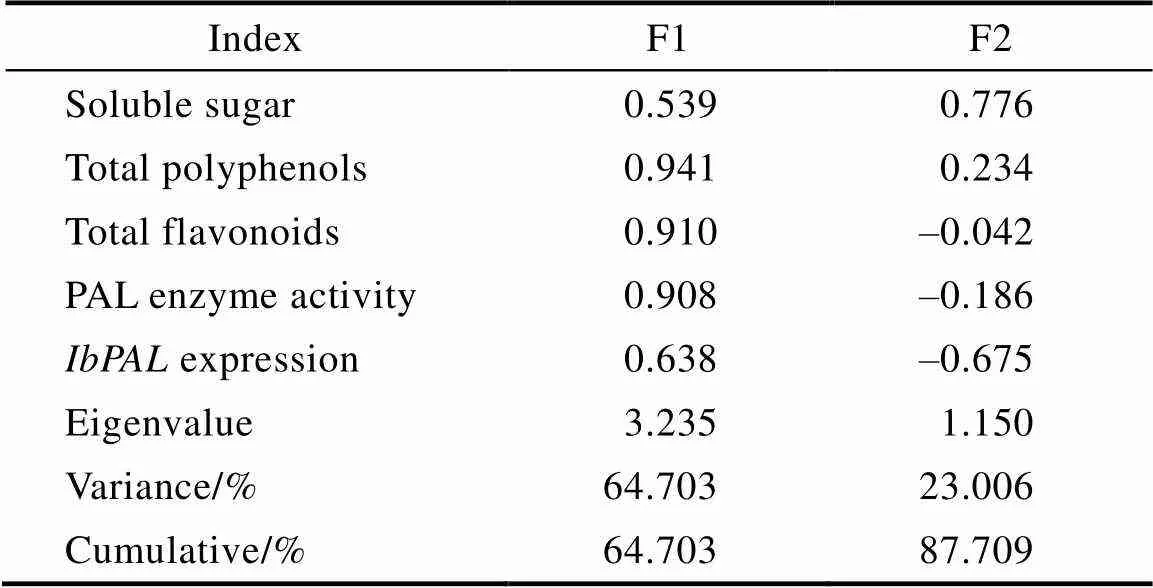
Tab. 5 Eigenvectors and percentages of accumulated contribution of principal components
The total weight of each index was calculated by the proportion of five leaf-vegetable sweet potato indexes in each principal component and the proportion of the cumulative contribution rate of each principal component in the first two principal components (Tab. 6). The weight of five indexes was: total polyphenols > soluble sugar > total flavonoids > PAL enzyme activity >experiment.

Tab. 6 Total weight of leaf-vegetable sweet potato quality indexes
Note: FS1 is the first principal component score, FS2 is the second principal component score.
4 Discussion
Fertilization improves the growth and developmental condition of plants by providing them with an appropriate nutritional supply. Nitrogen fertilizer plays a major role in improving soil quality and providing plants with vital nutrients. The three main forms of nitrogen fertilizer have different effects on various crops. OZTURK[16]reported that the yield of seed and oil of two sunflower cultivars increased with an increasing amount of NO3–-N. In the present study, two leaf- vegetable sweet potato varieties were tested with different forms of nitrogen fertilizers. The results showed that the leaf-vegetable sweet potato stem tip yield reached its maximum at 65 DAT after transplanting and then decreased for all treatments. The yields observed in treatments N4and N5were statistically higher than that of the other treatments, whereas the yield under the N2treatment remained the lowest throughout the breeding period. The difference in yield between the two varieties was not significant. Comparing the different nitrogen ratios, it was observed that the N4and N5treatments provided more available NO3–-Nthan in the N2treatment. It could be speculated that the stem tip yields of the two leaf-vegetable sweet potato varieties are related to the availability of NO3–-N. This is consistent with the study of OZTURK[16]. This current result provides further evidence that NO3–-N is more conducive to the formation of leaf-vegetable sweet potato production than NH4+-N and CONH2-N.
Polyphenols and flavonoids in plants are important sources of natural antioxidants, widely found in fruits and vegetables, with antioxidant and disease prevention effects[17-18]. In addition, soluble sugar is widely present in the roots, stems, and seeds of plants, and it plays an important role in plant quality[19-20]; Therefore, the quantitative study of soluble sugar is of great significance to the quality characteristics of leaf-vegetable sweet potato. Tobacco plants grown in NO3–-N solutions have been shown to contain a higher level of polyphenols than those grown in NH4+-N solution[21]. However, WALCH-LIU[22]found an NH4+-N inhibitory effect on tobacco because of the lack of NO3--N that could be absorbed by plants. The results under the conditions of this experiment showed that the total polyphenols, total flavonoids, and soluble sugar content all peaked on the 65 DAT after transplanting, and the relevant indicators were the highest under treatment N4. The total polyphenols and flavonoids were the lowest in the N2treatment during the same period. This is consistent with the conclusions of SHEEN[21]. However, the results of this experiment were not entirely consistent with those of JUNG[18]in part due to soil nitrification which converts NH4+-N to NO3–-N. An alternate explanation may be different crop types and environments.
PAL is thought to be regulated by nitrogen sources and non-biological factors at the transcription levels[23]. PAL is the key enzyme that regulates polyphenol and flavonoid synthesis[24-25]. The accumulation of NH4+-N in rice leaves will lead to an increase in PAL enzyme activity[26]. PAL genes exhibited higher expression levels in tea plants supplied with NO3–-N[27]. Other studies also showed thatexpression was higher with a predominant supply of NH4+-N than that of NO3–-N. In addition, the increased PAL enzyme activity in tissues induced by NH4+-N may be due to secondary nitrogen assimilation pathways metabolized through phenylpropanoid[28-29]. In the present study, the PAL enzyme activity of leaf-vegetable sweet potato stem tips continuously increased in the early stages and then decreased sharply after peaking at 80 DAT. Enzyme activity was highest under N4treatment while treatment N2showed the lowest enzyme activity changes. PAL enzyme regulatory gene expression changes and enzyme activity changes have the same trend of change. Theunder N4treatment in both varieties was significantly highly expressed compared to other treatments and the gene expression at 80 DAT after transplantation was significantly higher than in the other periods. The results of this study are the same as those of FAN[27]but differ from those of SINGH[28]. As described above, although NO3–-N was found to be beneficial for the PAL enzymatic activity of stem tips in our experiments, NH4+-N was also found to be more beneficial in other crops. Therefore, it can be speculated that NO3–-N has the potential to improve the yield and quality of the stem tips by regulating the expression ofto provide more uptake during growth and development. This conclusion was also confirmed by correlation analysis, which showed the activity of total polyphenols, total flavonoids, and PAL enzymes were significantly correlated withexpression. The result has also shown that NO3–-N can regulate the synthesis of phenolic substances and the increase of enzyme activity by increasing the expression of the, thus affecting the quality of leaf-vegetable sweet potato. In the comprehensive model, the corresponding coefficient of each quality index is the weight of each index. According to the weight of each index, the importance of each index in the quality of leaf-vegetable sweet potato under the condition of nitrogen form ratio can be seen. The principal component analysis results of five quality indicators of leaf-vegetable sweet potato showed that the weight of total polyphenols, total flavonoids, and soluble sugar content was high, which were important indicators for evaluating the quality performance of leaf-vegetable sweet potato.
Throughout the growing season of sweet potato, the ratio of different forms of nitrogen had a significant effect on yield and quality. The effect of NO3–-N is higher than that of NH4+-N and CONH2-N, and the ratio of NO3–-N in the application scheme has been shown to improve the yield and quality of stem tips. In this study, the N4treatment was the best combination for the good yield and quality of leaf-vegetable sweet potato. Through research, we have selected a nitrogen form ratio that is more suitable for the growth and development of leaf- vegetable sweet potatoes, and we are committed to applying it to agricultural practices to improve our environment.
[1] MOHANRAJ R, SIVASANKAR S. Sweet potato ([L.] Lam)-a valuable medicinal food: a review[J]. Journal of Medicinal Food, 2014, 17(7): 733-741.
[2] JOHNSON M, PACE R D. Sweet potato leaves: Properties and synergistic interactions that promote health and prevent disease[J]. Nutrition Reviews, 2010, 68(10): 604-615.
[3] SUN H N, MU T H, XI L S, ZHANG M, CHEN J W. Sweet potato (L.) leaves as nutritional and functional foods[J]. Food Chemistry, 2014, 156(8): 380-389.
[4] YU Y, ZHANG Q, LIU S, MA P Y, JIA Z D, XIE Y Z, BIAN X F. Effects of exogenous phytohormones on chlorogenic acid accumulation and pathway-associated gene expressions in sweetpotato stem tips[J]. Plant Physiology and Biochemistry, 2021, 164: 21-26.
[5] RAMAKRISHNA A, RAVISHANKAR G A. Influence of abiotic stress signals on secondary metabolites in plants[J]. Plant Signaling and Behavior, 2011, 6(11): 1720-31.
[6] HUANG Z L, WANG B W, EAVES D H, SHIKANY J M, PACE R D. Phenolic compound profile of selected vegetables frequently consumed by African Americans in the southeast united states[J]. Food Chemistry, 2007, 103(4): 1395-1402.
[7] MACDONALD M J, D’CUNHA G B. A modern view of phenylalanine ammonia lyase[J]. Biochemistry and Cell Biology, 2007, 85(3): 273-282.
[8] AYDAS S B, OZTURK S, ASLIM B. Phenylalanine ammonia lyase (PAL) enzyme activity and antioxidant properties of some cyanobacteria isolates[J]. Food Chemistry, 2013, 136(1): 164-169.
[9] GHO Y S, KIM S J, JUNG K H. Phenylalanine ammonia-lyase family is closely associated with response to phosphate deficiency in rice[J]. Genes & Genomics, 2020, 42(1): 67-76.
[10] MEHDI S M, SARFRAZ M, SHABBIR G, ABBAS G. Effect of inorganic nitrogenous fertilizer on productivity of recently reclaimed saline sodic soils with and without biofertilizer[J]. Pakistan Journal of Biological Sciences, 2007, 10(14): 2396-2401.
[11] WALLING E, VANEECKHAUTE C. Greenhouse gas emissions from inorganic and organic fertilizer production and use: a review of emission factors and their variability[J]. Journal of Environmental Management, 2021, 276: 111-211.
[12] HARRISON K A, BOL R, BARDGETT R D. Preferences for different nitrogen forms by coexisting plant species and soil microbes[J]. Ecology, 2007, 88(4): 989-999.
[13] MUSCI M, YAO S C. Optimization and validation of Folin-Ciocalteu method for the determination of total polyphenol content of Pu-erh tea[J]. International Journal of Food Sciences and Nutrition, 2017, 68(8): 913-918.
[14] HOSSAIN M A, SHAH M D, GNANARAJ C, LQBAL M.total phenolics, flavonoids contents and antioxidant activity of essential oil, various organic extracts from the leaves of tropical medicinal plantfrom Sabah[J]. Asian Pacific Journal of Tropical Medicine, 2011, 4(9): 717-721.
[15] KARKACIER M, ERBAS M, USLU M K, AKSU M. Comparison of different extraction and detection methods for sugars using amino-bonded phase HPLC[J]. Journal of Chromatographic Science, 2003, 41(6): 331-333.
[16] OZTURK E, POLAT T, SEZEK M. The effect of sowing date and nitrogen fertilizer form on growth, yield and yield components in sunflower[J]. Turkish Journal of Field Crops, 2017, 22(1): 143-151.
[17] HALLIWELL B, RAFTER J, JENNER A. Health promotion by flavonoids, tocopherols, tocotrienols, and other phenols: direct or indirect effects? Antioxidant or not?[J]. The American Journal of Clinical Nutrition, 2005, 81(1): 268S-276S.
[18] JUNG J K, LEE S U, KOZUKUE N, LEVIN C E, FRIEDMAN M. Distribution of phenolic compounds and antioxidative activities in parts of sweet potato (L.) plants and in home processed roots[J]. Journal of Food Composition and Analysis, 2011, 24(1): 29-37.
[19] ZRENNER R, SCHULER K, SONNEWALD U. Soluble acid invertase determines the hexose-to-sucrose ratio in cold-stored potato tubers[J]. Planta, 1996, 198(2): 246-252.
[20] DIRK L M A, KROL A R V D, VREUGDENHIL D, HILHORS H W M, BEWLEY J D. Galactomannan, soluble sugar and starch mobilization following germination ofseeds[J]. Plant Physiology and Biochemistry, 1999, 37(1): 41-50.
[21] SHEEN S J, CALVERT J, REBAGAY G R. Effect of nitrogen fertilization on polyphenol content and oxidase activities in tobacco seedlings[J]. Crop Science, 1988, 9(5): 547-550.
[22] WALCH-LIU P, NEUMANN G, BANGERTH F, ENGELS C. Rapid effects of nitrogen form on leaf morphogenesis in tobacco[J]. Journal of Experimental Botany, 2000, 51(343): 227-237.
[23] OLSEN K M, LEA U S, SLIMESTAD R, VERHEUL M, LILLO C. Differential expression of the fourgenes;andhave functional specialization in abiotic environmental triggered flavonoid synthesis[J]. Journal of Plant Physiology, 2008, 165(14): 1491-1499.
[24] LEVY H L, SARKISSIAN C N, SCRIVER C R. Phenylalanine ammonia lyase (PAL): From discovery to enzyme substitution therapy for phenylketonuria[J]. Molecular Genetics and Metabolism, 2018, 124(4): 223-229.
[25] ZHANG Q, LIU Y, WU X M, SHU L Z, SONG Y X, CHEN C, LONG M H. Preliminary study on the effects of two different nitrogen forms on flavonoids accumulation and related molecular mechanism in medicinal plant[J]. Bulletin of Botanical Research, 2018, 38(3): 367-376.
[26] KOVACIK J, DRESLER S, PETERKOVA V, BABULA P. Nitrogen nutrition modulates oxidative stress and metabolite production in[J]. Protoplasma, 2020, 257(2): 439-447.
[27] FAN K, FAN D M, DING Z T, SU Y H, WANG X C. Cs-mir156 is involved in the nitrogen form regulation of catechins accumulation in tea plant (L.)[J]. Plant Physiology and Biochemistry, 2015, 97: 350-360.
[28] SINGH S, LEWIS N G, TOWERS G H N. Nitrogen recycling during phenylpropanoid metabolism in sweet potato tubers[J]. Journal of Plant Physiology, 1998, 153(3/4): 316-323.
[29] MOLLAVALI M, PERNER H, ROHN S, RIEHLE P, HANSCHEN F S, SCHWARZ D. Nitrogen form and mycorrhizal inoculation amount and timing affect flavonol biosynthesis in onion (L.)[J]. Mycorrhiza, 2018, 28(1): 59-70.
不同氮素形态配比对菜用甘薯产量和品质的影响
李成阳1,2,柴沙沙1*,刘 意1,2,Soviguidi Deka Reine Judesse1,2,王连军1,雷 剑1,程贤亮1,杨园园1,杨新笋1**,张文英2**
1. 湖北省农业科学院粮食作物研究所/湖北甘薯工程技术研究中心/粮食作物种植创新与遗传改良湖北省重点实验室,湖北武汉 430064;2. 作物抗逆技术研究中心/长江大学,湖北荆州 434025
菜用甘薯存在产量低、品质差以及在种植过程中由于不合理施肥造成生态环境恶化等问题,因此,针对以上问题开展本研究。氮肥作为农业肥料投入的主要部分,是影响菜用甘薯产量和品质的重要因素,通过设置不同氮素形态配比处理,根据菜用甘薯茎尖产量和品质相关指标的变化,揭示菜用甘薯产量和品质对氮素形态配比的响应机制,为提升菜用甘薯产量和品质的同时减轻因不合理施肥造成环境污染提供理论依据。本研究为大田试验,供试品种为生产上主栽的2个菜用甘薯品种‘福薯18’(F18)和‘鄂薯10号’(E10),采用两因素裂区试验设计,设5个氮素形态配比处理为:(1)NH4+-N∶NO3–-N∶CONH2-N=1∶1∶1 (N1);(2)NH4+-N∶NO3–-N∶CONH2-N= 1∶0∶2 (N2);(3)NH4+-N∶NO3–-N∶CONH2-N= 2∶0∶1 (N3);(4)NH4+-N∶NO3–-N∶CONH2-N= 1∶2∶0 (N4);(5)NH4+-N∶NO3–-N∶CONH2-N= 2∶1∶0 (N5)。研究结果表明,N4和N5处理均可显著提高菜用甘薯的茎尖产量、总酚含量、总黄酮含量、可溶性糖含量、苯丙氨酸解氨酶(PAL)酶活性和基因表达量;同一时期不同处理间差异显著,随着生育期的不断推进,各项指标的变化呈先升后降的趋势,其中以N4处理效果更为显著,除可溶性糖含量在N3处理下最低外,其他各项指标均在N2处理下最低,由相关性分析证实,总酚、总黄酮和可溶性含量及PAL酶活性与基因表达量呈显著正相关,而可溶性糖含量与基因表达量呈负相关,表明可溶性糖含量的变化与基因表达无相关性;由氮素形态配比处理可知,相对于N2和N3处理,N4和N5处理为植株提供了更多的NO3–-N,由此推断NO3–-N在菜用甘薯生长发育过程中起到更为重要的促进作用,而CONH2-N在本研究中对甘薯产量和品质的促进作用并不突出。而N4处理即NH4+-N∶NO3–-N∶CONH2-N= 1∶2∶0的配肥方案是促进菜用甘薯产量和品质提升的最佳配施组合。本研究结果可为合理配肥以获得理想的作物产量和品质提供理论依据,为在其他作物上开展相关研究提供参考。
菜用甘薯;氮素形态配比;总酚;总黄酮;可溶性糖;苯丙氨酸解氨酶
S531
A
2021-11-03;
2021-12-01
国家重点研发计划项目(No. 2019YFD1001300,No. 2019YFD1001304);财政部和农业农村部国家现代农业产业技术体系项目。
10.3969/j.issn.1000-2561.2022.07.016
李成阳(1996—),男,硕士研究生,研究方向:甘薯栽培生理;*同等贡献作者:柴沙沙(1987—),女,硕士,助理研究员,研究方向:甘薯栽培生理。**通信作者(Corresponding author):杨新笋(YANG Xinsun),E-mail:yangxins013@163.com;张文英(ZHANG Wenying),E-mail:wyzhang@yangtzeu.edu.cn。
